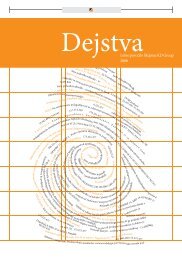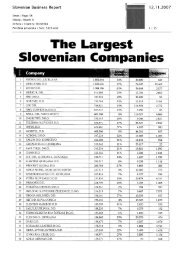We build business networks and relationships ... - skupina kd group
We build business networks and relationships ... - skupina kd group
We build business networks and relationships ... - skupina kd group
Create successful ePaper yourself
Turn your PDF publications into a flip-book with our unique Google optimized e-Paper software.
KD Holding Group<br />
Notes to Consolidated Financial Statements as at <strong>and</strong> for the year ended 31 December 2007<br />
The opinion on the adequacy of liabilities for 2007<br />
- to be added when the test is carried out<br />
Liabilities as calculated using LAT as per<br />
31.12.2007 are lower than liabilities the Group<br />
recognised in its financial statements using its own<br />
methodology. The test has proven the adequacy of<br />
liabilities formed for life insurance contracts.<br />
The Group first adopted LAT for fiscal year 2006.<br />
expenses attributable to the unexpired periods of<br />
policies in force at the balance sheet date with the<br />
amount of unearned premiums in relation to such<br />
policies after. Expected cash flows relating to claims<br />
<strong>and</strong> expenses are estimated by reference to the<br />
experience during the expired portion of the contracts,<br />
adjusted for significant individual losses which are not<br />
expected to recur.<br />
The test proved the adequacy of liabilities for life<br />
insurance contracts as at 31.12.2006.<br />
The opinion on the adequacy of liabilities for 2007<br />
The results show no deficiency in the liabilitiy<br />
2. Liability adequacy test for property <strong>and</strong> health<br />
amount for either 2007 or 2006.<br />
insurance<br />
The liability adequacy test for property insurance<br />
contracts is carried out for liabilities attributable to<br />
3.1.1 Estimate of future benefit payments <strong>and</strong><br />
premiums arising from long-term insurance contracts<br />
the unearned premium reserve <strong>and</strong> related DAC. <strong>We</strong><br />
consider that the formed liabilities for damages <strong>and</strong><br />
liabilities for bonuses <strong>and</strong> discounts are based on<br />
undiscounted test estimates of management using<br />
actuarial techniques are adequate so no further<br />
adequacy test is considered necessary.<br />
The liability adequacy test for property <strong>and</strong> health<br />
insurance was performed for all insurance liabilities.<br />
Insurance liabilities related to incurred <strong>and</strong> reported<br />
claims <strong>and</strong> incurred but not reported claims are<br />
calculated by using current assumptions <strong>and</strong> therefore<br />
represent the best estimation of the current liabilities<br />
from the insurance contracts.<br />
The liability adequacy test is therefore limited to the<br />
unexpired portion of existing contracts. It is performed<br />
by comparing the expected value of claims <strong>and</strong><br />
The determination of the liabilities under long-term<br />
insurance contracts is dependent on estimates<br />
made by the Group. Estimates are made as to the<br />
expected number of deaths for each of the years in<br />
which the Group is exposed to risk. The Group bases<br />
these estimates on st<strong>and</strong>ard industry <strong>and</strong> national<br />
mortality tables that reflect recent historical mortality<br />
experience, adjusted where appropriate to reflect the<br />
Group’s own experience. For contracts that insure<br />
the risk of longevity, appropriate but not excessively<br />
prudent allowance is made for expected mortality<br />
improvements. The estimated number of deaths<br />
determines the value of the benefit payments <strong>and</strong> the<br />
value of the valuation premiums. The main source<br />
of uncertainty is that epidemics such as AIDS, SARS<br />
<strong>and</strong> wide-ranging lifestyle changes, such as in eating,<br />
smoking <strong>and</strong> exercise habits, could result in future<br />
mortality being significantly worse than in the past for the<br />
233







